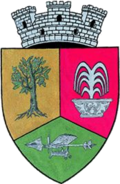Geoagiu
|
Geoagiu Gergesdorf Algyógy |
||||
|
||||
| Basic data | ||||
|---|---|---|---|---|
| State : |
|
|||
| Historical region : | Transylvania | |||
| Circle : | Hunedoara | |||
| Coordinates : | 45 ° 55 ' N , 23 ° 12' E | |||
| Time zone : | EET ( UTC +2) | |||
| Height : | 217 m | |||
| Area : | 155.69 km² | |||
| Residents : | 5,294 (October 20, 2011) | |||
| Population density : | 34 inhabitants per km² | |||
| Postal code : | 335400 | |||
| Telephone code : | (+40) 02 54 | |||
| License plate : | HD | |||
| Structure and administration (as of 2016) | ||||
| Community type : | city | |||
| Structure : | 10 districts / cadastral communities: Aurel Vlaicu , Băcâia , Bozeș , Cigmău , Gelmar , Geoagiu-Băi , Homorod , Mermezeu-Văleni , Renghet , Văleni | |||
| Mayor : | Vasile Cărăguț ( ALDE ) | |||
| Postal address : | Calea Românilor, no. 141 loc. Geoagiu, jud. Hunedoara, RO-335400 |
|||
| Website : | ||||
Geoagiu ( Hungarian Algyógy , German Gergesdorf ) is a small town in Romania in the Hunedoara district .
Geographical location
Geoagiu is on the river Mureş ( Mieresch ) at an altitude of 217 m . The Geoagiu river of the same name flows into the Mureș there. A railway line and the county road ( drum județean ) DJ 705 connect Geoagiu with the European route 68 . The Romanian A1 motorway will , when it is finished, run in the area of the small town.
history
The first information about the existence of the place goes back to the time of the Dacians in the first millennium BC, as a number of relevant archaeological discoveries were made in the area. Based on many historical theories, the name of the fortress Germisara , which was built after the Roman conquest at the beginning of the 2nd century AD, is of Dacian origin. The Roman fort was built on an older, Dacian citadel.
The name Germisara means hot water ( germi = heat, sara = waterfall ) and refers to the thermal springs in the area, which were already known to the Dacians and which were later explored and developed by the Romans.
Geoagiu was first mentioned in a document in 1291. The name was used in a document adjoining a plot of land in Binținți (today the village is called Aurel Vlaicu ).
At the beginning of 1397 Geoagiu became the residence of a large noble estate. The last owner of the estate was János Corvin , the son of Matthias Corvinus , who owned the land until 1506. After that it became the property of the Hungarian king. A year later, on December 5, 1507, it was donated to Radu the Great , ruler of a Romanian principality, his wife Anca and their son Vlad. During this period the importance of Geoagiu increased; in 1510, the city received market rights, as a curia, i.e. the home of the nobleman, was located there.
From 1517 it became the property of the Romanian prince Neagoe Basarab for 14 years ; he had the place administered by the nobles Horvat and Cioara appointed by him.
In 1531 King John Zápolya secularized the monastic property of Geoagius. Together with 18 villages in the area, he donated the place with his ruler's seat in the middle to his most devoted army leader Kún Kocsárd .
After the union with Romania on December 1, 1918, the former noble estates and some adjacent areas were formed into a rural district of Geoagiu.
In June 2001, Geoagiu was officially declared a city in Romania as the first place in the new millennium.
The city has about 3,000 inhabitants, with the surrounding incorporated villages there are about 5,000.
economy
The city generates its income from the production of agricultural products and from tourism.
Attractions
- Ruins of the Roman fortress west of the city on the border with the village of Cigmău
- An old Roman road from Geoagiu to Geoagiu-Băi
- A Roman thermal spring in Geoagiu-Băi, which was connected to the castle by a terracotta aqueduct
- The Natau Lake is a paradise for anglers. The summit on an adjacent hill of the lake is an excellent vantage point.
- Churches: Bozeș Church from the 15th century, the Christian Paleo Church from the 12th century and the City Church of Geoagiu from the 15th century
Web links
Individual evidence
- ↑ 2011 census in Romania at citypopulation.de
- ^ City website, accessed May 15, 2010


